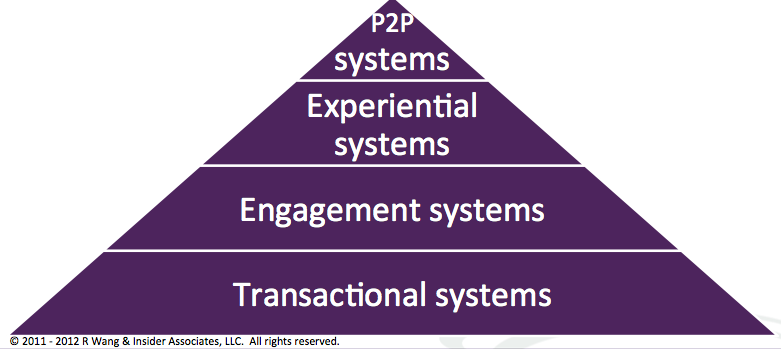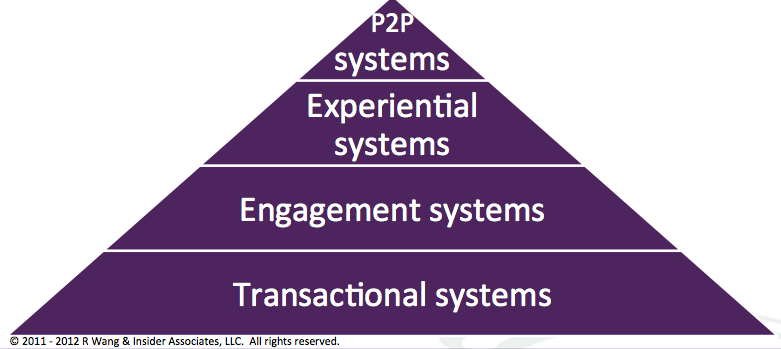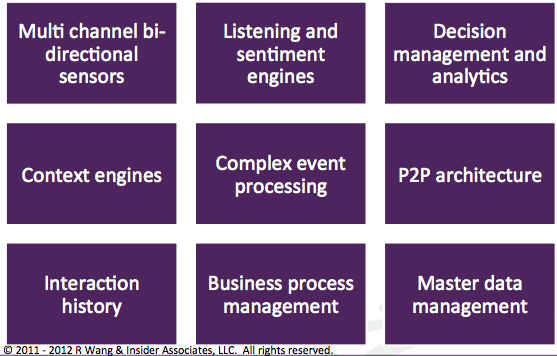
Monday's Musings: The New Engagement Platform Drives The Shift From Transactions

Convergence In The Five Forces Of Consumerization Of Technology Drives The Next Big Thing
Social has given us the tools to connect. Mobile has given us the ability to interact any time and anywhere. Cloud delivers access points to us with a rich array of content and information. Big data provides us with the context and information to make decisions. Unified communications and video transform how we share ideas. This convergence of the five forces of consumerization drives the next shifts in technology. The move from transaction to engagement and from engagement to experience is happening now. The era of transactional apps rapidly makes way for the era of engagement.
If Business Value And Outcomes Are The Goal, Then We Need An Engagement Platform For The Enterprise
The arrival of engagement platforms does not signify time to throw out the transactional systems. In fact, those systems provide the foundation required for engagement. The engagement layer exposes transactions and allow for deeper interaction and richer sources of information. However, the transactional systems lack the ability to support engagement.
In fact, organizations around the world struggle with building the right engagement strategy for their customers and employees. While crafting the right strategy should be designed prior to any technology selection, once completed, the technology to support the strategy does not exist out of the box from ANY solution provider. Unfortunately, the technologies to achieve engagement remain disparate and hodge podge. Many solution providers seek to achieve the engagement layer from different heritages:
- Pure play social solutions morph to engagement apps. Vendors such as Broadvision, Jive, Moxie, Lithium, Tibco, and Yammer have delivered many elements of the engagement layer. These horizontal offerings provide an opportunity to assimilate disparate offerings across multiple processes and roles. The challenge is finding the tools that support consistent integration at the process, meta data, and data layer. Gamification vendors such as Badgeville, Bunchball, BigDoor, Crowdtwist, and Gigya play a key role in delivering outcomes and influencing behavior through engagement. Platforms such as Atlasian, Box, GoodData, and Tidemark open the door to a new era of engagement apps.
- Legacy transactional systems in transition to engagement. Major ERP and CRM vendors seek to address engagement with "social" and "mobile" features. While many of the vendors have the components for engagement, the struggle will be to embed a sense and respond design point into both the interaction layer and process flows. Salesforce embraces the social enterprise and uses Chatter as its entry point in creating engagement. SAP attempts this with its CubeTree/SuccessFactors acquisition in Project Robus. Oracle attacks this problem through a customer experience suite. Microsoft acquired Yammer to create this layer inside Office and its Business Solutions portfolio. IBM embraces social business with a series of acquisitions and product enhancements to its IBM Connections product. More importantly, IBM has built and acquired a portfolio of software solutions that sit on top of the legacy transactional systems, delivering high value and high impact.
- Consumer offerings could enter the enterprise. With consumerization of IT increasing, platforms such as Facebook, LinkedIn, Pinterest, and Twitter provide a rich engagement platform that could be adopted in the enterprise. Meanwhile, solutions providers such as Adobe blend consumer with enterprise as they provide the tools for engagement on the web and in mobile. The challenge is dealing with societal norms between work and personal information. The challenge is meeting enterprise class requirements for safety, security, and sustainability.
- Vertically integrated prosumer platforms already deliver engagement. Google, Amazon, Apple, and Microsoft have the unique capability of delivering an end to end solution from hardware, consumer device, operating system, database, applications, and partner ecosystem. Engagement platforms form the basis of future business models as consumer and enterprise blend into prosumers. The challenge is meeting the disparate needs of enterprise and consumer.
- Marketing and advertising networks provide rich profiles and targeting. The ad networks are moving fast to shift engagement and offers. While daily deal sites play one role, companies like Glam Networks also now deliver key components for ad targeting and optimization that compete with Google, Apple, Yahoo, and other media properties. Marketing automation platforms such as
Eloqua, Hubspot, InfusionSoft, Marketo, NeoLane, Pardot, and Parature already have may key components. The challenge is engendering trust among the users or consumers to share more information in exchange for deemed value.
Figure 1. Technologies Will Evolve From Transactions to P2P
The Engagement Platform Requires Nine Main Technology Components
Mapping engagement requires a series of core components and platforms that span across business processes, disparate applications, and myriad of user roles. As many organizations face cloud/SaaS best of breed integration hell, the principles behind SOA ring truer than ever. Constellation's identified nine core components that should be standardized across apps to support this engagement layer and allow for an engagement platform to emerge (see Figure 2). Some components will come off the shelf, others from existing technologies, and many will have to be pieced together. Why? An out of the box engagement platform does not exist in the market. The nine components include:
- Multi-channel bi-directional sensors. The engagement layer serves a sense and respond design point. Feedback loops drive the engagement strategy. Real time response requires a new level of information gathering and capability to respond. Bionic API's will emerge when we shift to the experience layer.
- Listening and sentiment engines. Sensors require intelligence. Listening and sentiment analysis provides insight into the larger unstructured world. As sensors pick up more and more unstructured information, listening and sentiment allow us to categorize patterns which can later parlay to insight and provide input into context.
- Decision management and analytics. The engagement layer enables better decision making. Data on its own is just dumb data. Data will transform into information. Information leads to insight. Insight will drive our ability to make better decisions. Experience layer will shift to predictive models.
- Context engines. Relevancy comes from context. The shift from real time to right time requires relevancy and drives a major component of engagement. Context comes from roles, relationships, location, time, business process, sentiment, and intent. At some point, context enables prediction when we shift to experiential systems.
- Complex event processing (CEP). Mastering mass information requires pattern recognition. CEP delivers the intelligence to recognize and anticipate behaviors. CEP assists in determining context and also modeling event hierarchies. CEP supports the deliver of segmented value chains and networks. Expect the CEP layer to detect and verify trust in the network.
- P2P architectures. More than just identity management, systems must account for the people to people (P2P) interactions. An individual may play multiple roles and each role needs to be modeled and supported in a P2P architecture. Going forward a machine to machine (M2M) architecture will emerge in parallel with similar attributes and characteristics.
- Interaction histories. Every touch point, both physical and digital, requires tracking. Interaction histories provide a repository for storing, surfacing, and serving up this information. Engagement is tracked in the interaction history. Engagement is exposed in the interaction history.
- Business process management (BPM) and adaptive case management (ACM). Organizations will model processes across many disparate systems and integration points. BPM provides the glue to connect systems to people to outcomes. Defined outcomes will map back to metrics, which map back to business processes, which tie back to individuals accountable for outcomes. Variants such as adaptive case management play a critical role in addressing unpredictable run-time scenarios.
- Master data management (MDM). Common objects such as people, resources, assets, location, contracts, channels require a centralized repository for update and tracking. MDM serves as a key foundation for ensuring consistency and veracity in the engagement layer.
Figure 2. Nine Components Of The Engagement Platform

The Bottom Line: The End Game Is Driving Business Value Through Outcomes
The move to engagement platforms is not about a technology shift but a business value shift to achieving outcomes. Sophisticated organizations now buy business value through SLA's. The solution provider who can deliver outcomes will win in the shift to engagement platforms regardless of whether its software, services, or delivery models. Thus, the business challenges will focus on engagement for:
- The Future of Work
- Next Generation Customer
- Matrix Commerce
- Data to Decisions
- Digital Marketing Transformation
Your POV.
Am I missing any components? what else should be included? Do you have an engagement layer? How are you putting this together? What’s next for your engagement strategy? Have a story on how you’ve achieved engagement? Add your comments to the blog or send us a comment at R (at) SoftwareInsider (dot) org or R (at) ConstellationRG (dot) com
Please let us know if you need help with your business strategy efforts. Here’s how we can assist:
- Assessing social business/social CRM readiness
- Developing your social business engagement strategy
- Designing a data to decisions strategy
- Create a new vision of the future of work
- Deliver a new customer experience strategy
- Crafting a new matrix commerce strategy
- Moving from classic marketing to digital marketing transformation
Related Research:
- Tuesday’s Tip: Why Context Matters – Forget Real-Time, Achieve Right-Time
- Monday’s Musing: Avoiding Social Media Fatigue Through Engagement
- Friday’s Features: Using Attensity Analyze 6.0 To Compare Customer Sentiment For @united @southwestair @virginamerica
- Event Report: Lithium Network Conference 2012 #LiNC
- Best Practices: From First To Worst – Continental In A Post United World, Lessons In Next Gen Customer Experience
- Monday’s Musings: Seven Basic Privacy Rights Users Should Demand For Social Business
- News Analysis: Lithium Technologies Adds $53M in Financing
- Monday’s Musings: Balancing The Six S’s In Consumerization Of IT
- Monday’s Musings: A Working Vendor Landscape For Social Business
- Product Review: Google+, Consumerization of IT, and Crossing The Chasm For Enterprise Social Business
- Monday’s Musings: Using MDM To Build A Complete Customer View In A Social Era
- Monday’s Musings: Mastering When and How High End Brands Should Use Daily Deal Sites Such As Groupon
- News Analysis: Salesforce.com Acquires Radian6 For $316M
- Monday’s Musings: Q1 2011 State of Social CRM and CRM From An EMEA Point Of View
- Best Practices: Applying Social Business Challenges To Social Business Maturity Models
- Research Summary: Software Insider’s Top 25 Posts For 2010
- Best Practices: Five Simple Rules For Social Business
- Research Report: Constellation’s Research Outlook For 2011
- Research Report: How The Five Pillars Of Consumer Tech Influence Enterprise Innovation
- Research Report: Next Gen B2B and B2C E-Commerce Priorities Reflect Macro Level Trends
- News Analysis: Jive Fills Warchest, Ready to Battle Enterprise Software Giants And IPO?
- Tuesday’s Tip: Applying The Five Stages Of Adoption Towards SCRM Projects
- News Analysis: Lithium’s Acquisition of Scout Labs Ups The Ante in Social CRM
- News Analysis: Biz360 Acquisition Signals Attensity Group’s Move Into Social CRM
- Monday’s Musings: Avoiding Failure In Social CRM Projects Requires Ecosystem Coordination
- Research Report: The 18 Use Cases of Social CRM – The New Rules of Relationship Management
- News Analysis: Siperian Acquisition Vaults Informatica Into An MDM Leadership Position
- News Analysis: Jive and Radian6 Partner – Great For Business, But Could Fragment IT Systems
- Event Report: Salesforce.com Pushes Social CRM Technology — But Don’t Expect Companies To Be Successful With Tools Alone
- Monday’s Musings: Why Every Social CRM Initiative Needs An MDM Backbone
- Personal Log: Altimeter Group – Helping Organizations Bridge The Technology Obsolescence Gap
- Monday’s Musings: 10 Essential Elements For Social Enterprise Apps
Reprints
Reprints can be purchased through Constellation Research, Inc. To request official reprints in PDF format, please contact Sales .
Disclosure
Although we work closely with many mega software vendors, we want you to trust us. For the full disclosure policy, stay tuned for the full client list on the Constellation Research website.
* Not responsible for any factual errors or omissions. However, happy to correct any errors upon email receipt.
Copyright © 2001 – 2012 R Wang and Insider Associates, LLC All rights reserved.
Contact the Sales team to purchase this report on a a la carte basis or join the Constellation Customer Experience!
 R "Ray" Wang
R "Ray" Wang R "Ray" Wang
R "Ray" Wang